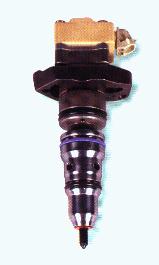 7.3 Injector
|
Understanding how the injectors work on the PowerStroke engine can help in diagnosing a concern with this engine. Older diesels used a hydraulic injection system in which fuel pressurized by the injection pump would actuate the injector. The drawback to this system is that any air which enters the fuel lines will affect the operation of the injectors, or even prevent them from operating. Also, the amount of fuel injected is dependent on the mechanical operation of the injection pump governor, which adjusts volume based on engine load/RPM. Gasoline engines with electronic injection use a pressurized fuel system and the computer varies the actuation of the injector based on input from various sensors in order to control the amount of fuel to the cylinders. Since gasoline engines have an ignition system to ignite the air/fuel mixture in the cylinders, fuel pressure only needs to be sufficient to supply the injectors and provide an adequate spray pattern to ensure efficient combustion. But a diesel engine uses heat from compression to ignite the air fuel mixture, and this high compression requires high injection pressures. What has been done on the PowerStroke is both of these systems are used in conjuntion with each other. Fuel is supplied to the injectors through fuel rails inside the cylinder heads. Also supplied to the injectors is high pressure engine oil. As the computer determines that a cylinder should fire it signals the Injector Driver Module. The IDM sends a 110 volt pulse-width modulated signal to the injector solenoid. When the injector solenoid is actuated, it opens a poppet valve which allows high pressure oil to flow into the intensifier piston. The intensifier piston is forced down, pressurizing the fuel inside the injector. When fuel pressure inside the injector reaches approximatly 2700 psi, it causes the injector pintle to rise off its seat and fuel is injected into the cylinder from the nozzel. As long as the poppet valve is open and oil is flowing into the injector, fuel will be injected. The computer controls how long the injector solenoid is energized (pulse-width, or time on in milliseconds), but it also determines the pressure of the fuel being injected by controlling the pressure of the oil (IPR duty-cycle, or the percentage of time on vs. off--AKA dwell) in the cylinder heads. The computer determines this based on engine load and driver demand by monitoring various sensors. Since the cavity at the top of the intensifier piston is seven times the size of the fuel cavity at the bottom, fuel is injected at a pressure seven times that of the computer-controlled oil pressure--oil pressure 3000 psi = injected fuel pressure 21000 psi. Due to the high oil system pressures, the spring which closes the poppet valve once the injector solenoid is deactivated has to be very strong--and because of this, the solenoid needs to be 110 volts. Once the poppet valve is closed, spring pressure returns the injector to its normal state and the oil is exhausted into the valve cover area to return to the sump. Because of the nature of how this system operates, air in the fuel is not as great of a concern as air in the oil. The PowerStroke requires a special anti-foaming agent in its oil to prevent this aeration. Oils with an API service rating of CF-4 or CG-4 already have this agent, but it becomes depleated as the oil breaks down, so regular oil changes (3000-5000 miles depending on vehicle use) are necessary. The anti-foaming agent can also be depleated by interaction with some silicone sealers. Split-Shot OperationSplit-shot injectors were originally installed on 1996 and 97 model/year trucks with California emissions, and are used in engines from 98.5 on. These injectors prolong the injection time to decrease emissions without reducing power. Fuel is delivered to the injector (green) past a check valve in the same manner as in the standard injectors. As the intensifier piston is forced down the fuel is pressurized (orange) and the check ball (blue) is lifted off its seat and fuel injection begins. Cut into the piston is a land (yellow) which receives fuel through bleed holes (red) as it is pressurized. As the piston travels down the land aligns with a port in the injector. When this happens, pressure drops below the piston and the check ball reseats and injection is suspended. As the piston travels further, the port in the injector is covered and fuel injection recommences. 6.0 PowerStroke InjectionThe injection system on the 6.0 PowerStroke works in much the same way as on the 7.3. The injectors are still computer-controlled and hydraulically operated, but the design of the system does have differences. Instead of an Injection Driver Module that only engergizes the solenoid on based on the commands of the engine control computer, it has a Fuel Injector Control Module (FICM) that is networked with the computer. The computer sends sensor information to the FICM, and the FICM itself makes the calculations on how long to turn on the injectors. In addition, instead of utilizing a spring to close the injector once the solenoid is turned off, the injector has two solenoids. One solenoid shifts a spool valve to one side to allow oil into the top of the injector, then a second solenoid is energized to shift the valve the other direction to close the injector. This allows for a smaller injector that requires lower actuating voltage (48 volts maximum), which results in quieter injector operation and allows enough room for four valves per cylinder. Finally, instead of a high pressure oil passage machined in the heads, the 6.0 has an oil rail that is attached to the tops of the injectors under the valve cover. Early 6.0's had a function similar to the split shot injection of the 7.3's called pilot injection. Instead of being a hydro/mechanical action, however, on each compression stoke the FICM would energize the injector once to start combustion, turn the injector off, then energize it again. This was to provide less engine noise and improved emissions. But, this programming caused timing problems on hot restarts, resulting in rough running and loping, so the strategy was programmed out in later calibrations. 6.4 PowerStroke InjectionNew for the 6.4 PowerStroke is the high pressure common rail fuel injection system with piezo-electric injectors. While technically the 7.3 and 6.0 PowerStrokes had a common rail system (all injectors fed from a common fuel rail and not individual lines), it was classified differently due to the high pressure oil system used to actuate the injectors. The high pressure oil pump has been replaced by a high pressure (up to 26,000 PSI) fuel pump driven off the camshaft at the rear of the engine. Built into the high pressure pump are computer-controlled fuel pressure and volume control valves. The high pressure pump supplies the injectors fuel through fuel rails under the valve covers. Fuel returns from the rails back to the tank through the same cooler used by the VGT actuator. The piezo-electric injectors are designed to provide more precise fuel control through multiple injection (up to 5 injections per combustion event) with reduced noise. Fuel is supplied to two chambers in each injector: the high pressure (delivery) chamber at the nozzle, and the control piston chamber. The nozzle needle is held closed by a spring and by fuel pressure in the control chamber. The injector is actuated when the engine control module (ECM) sends a high-voltage signal to the piezo actuator at the top of the injector. The piezo discs in the actuator flex and press on a hydraulic check valve, which causes fuel pressure in the control chamber to bleed off. Fuel pressure in the high pressure chamber causes the nozzle needle to lift off its seat and fuel passes through the spray holes at the nozzle tip. The ECM deactivates the injector by reversing polarity to the piezo discs. This allows spring pressure to close the check valve, fuel pressure builds in the control chanber, and the nozzle needle closes, ending injection. The ECM alone controls injector operation, with no extermal IDM/FICM as found on the 7.3 and 6.0 PowerStrokes.
|
Back to dieselmann's Page
PowerStroke Page
Tech Page
Diesel Injector Service; For all of your diesel engine needs:
Injection systems, filters, O-ring kits, accessories and fuel conditioners. Product Catalog
Amsoil product information--lubricants and filters.
Check out a large section of Ford F150 accessories for your Ford truck at AmericanTrucks.

 ©
©  ©
©